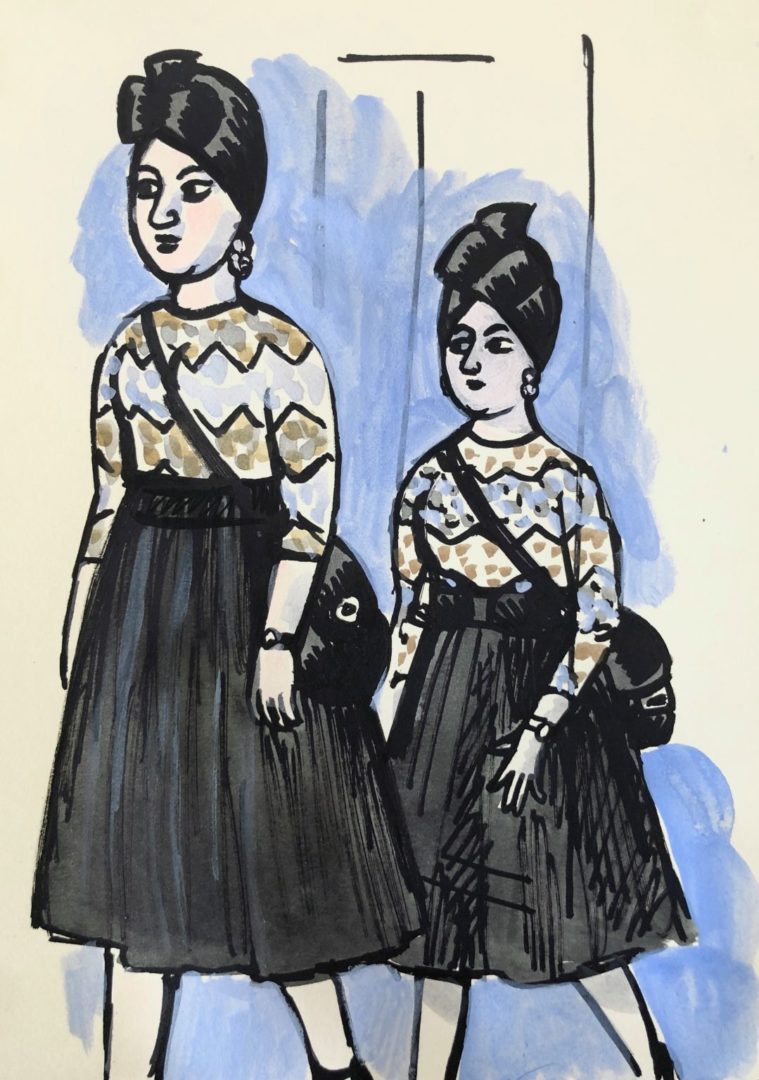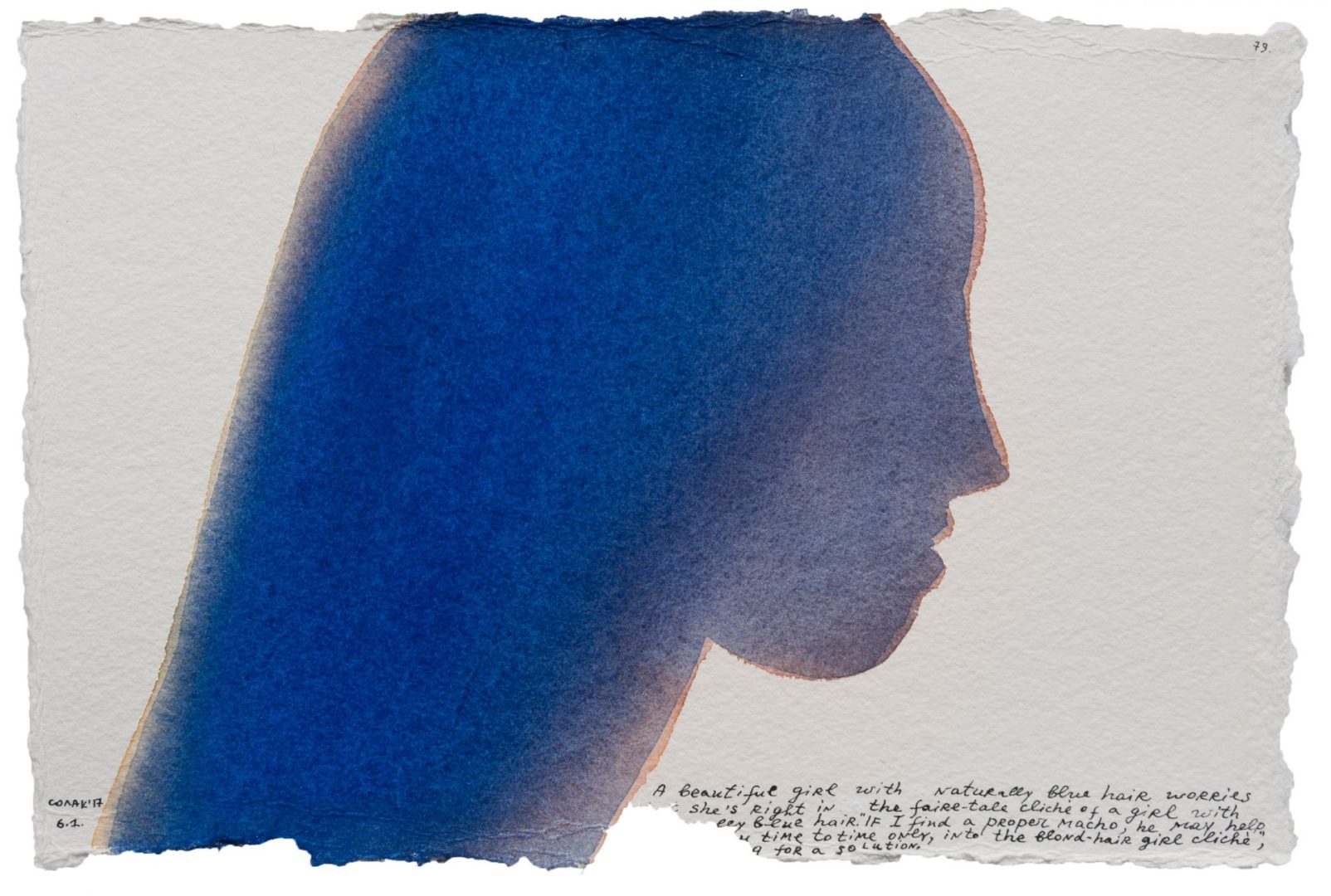
Courtesy of the artist and Rosenfeld Gallery, Tel Aviv
The most common head covering, worn by most Jews during religious ceremonies, is a symbol of humility and the fear of heaven. An etymology—fictive, no doubt, but nonetheless full of meaning—links yarmulke, the Yiddish word for kippah, to the Aramaic expression yira malka meaning “fear of heaven.” The kippah can be seen as a continuation of the head coverings worn by priests in the Temple, symbolically expressing the perpetual awareness of a transcendent presence pushing us to continually readjust our conduct here on earth. Long a part of Jewish custom, this head covering finds its origins in Rav Huna, son of Rav Yehoshua, who the Talmud tells us “did not walk four cubits bareheaded, for the sake of the Divine Presence.” Only later did head coverings become required during prayer; from there, the practice extended to all aspects of life by the Middle Ages. Today the kippah is mostly worn by men, although many halakhic authorities judge that women (regardless of marital status) should also cover their heads minimally during prayer. The cap does, of course, cover the head, but it does nothing to conceal any locks of hair whose presence might offend or distress. Wearing the kippah, then, is a free and independent gesture of submission to the divine, as much as it is a bodily ritualization of an eye gazing down from above. It is a gesture with an ascendant trajectory.
A CROWN, OR A MARK OF SHAME? FEMALE HEAD COVERINGS IN TALMUDIC LITERATURE
The head covering worn by most married Orthodox women, however, stems from an entirely different set of reasoning. These days, we hear many arguments extolling, with a somewhat mollifying gloss, the female head covering. Some praise it as a way to control male jealousy; others declare there can be no queen without her crown, no diamond without its case; while others still, presenting themselves as budding kabbalists, describe, in trembling tones, the cosmic upheavals the kisui rosh (head cover) will work upon the heavens. It bears mentioning that there is Talmudic precedent here. A staple of rabbinic discourse, for example, is the account of the mother whose hair was never even seen by her own walls and who, accordingly, merited having children who became high priests. Care is taken, however, to stress that narratives such as this are not sources of law but rather describe individual acts of piety (hasidut) which go above and beyond moral requirement.
An analysis of rabbinic literature reveals a very different rationale behind head coverings worn by women. Several Talmudic sources, for instance, present the head covering as a consequence of women’s social exclusion – which we shall loosely call patriarchy – and, more generally, of their cursed metaphysical condition, i.e. a present state of damnation that is not the ideal state of things but rather is the unfortunate consequence of transgression and hints at the possibility of redemption or restitution. Most of these texts, it should be noted, are descriptive rather than prescriptive; in other words, the sages of the Talmud do not present themselves as lawmakers imposing the head covering on women, but rather as describing a feminine norm they assume to be universal. Moreover, although some sources contend that the requirement of head coverings for the daughters of Israel is a matter of biblical law (T.B. Ketubot 72a), in the Talmud it is rather a matter of dat Yehudit. That is to say, it is a matter of custom, based on ideas of sexual morality that consider wind-tousled hair as being the first step towards nudity out of wedlock and depravity, as Mishnah Ketubot 7.6 indicates: “And what is Jewish practice [dat Yehudit]? Going out with her head uncovered, spinning wool in the marketplace or conversing with every man.”
Another Talmudic passage, which appears many times and in many variations, views the female head covering as a symbol of disgrace:
“Why does a woman cover her head but a man does not cover his head? They told a parable; to what is it similar? To a woman who disgraced herself with immoral actions and she is embarrassed in front of others over the disgrace. Thus, Eve disgraced herself with immoral actions and caused her daughters to cover their heads.” (Avot deRabbi Nathan, version B, chapter 9, Schechter ed. 13a, tr. Naftali S. Cohn)
“Ten [curses came down upon] Eve. (…) The eighth: that she sits in the house and does not provide for her own needs as a man does. The ninth: that she goes out to the market with her head covered like a mourner.” (Avot deRabbi Nathan, version B, chapter 42, Schechter ed. 59a, tr. Naftali S. Cohn)
Before coming down too hard on the text, let us at least acknowledge the radical honesty of these words, so far removed from the apologia of today. That women cover their heads is, in the Talmud, an undisputed. The Talmud rather reflects on the perception of the female head covering as a symbol of disgrace. Far from being the “crown” of the “princesses of Israel,” kisui rosh is compared to a veil drawn by a crook in search of anonymity, or to the bereaved, who in Talmudic times mourned by covering their faces to the chin (atifat ha-rosh) and isolating themselves, symbolically and physically, from society.
Later, another well-known passage of the Talmud enumerates the female features that are considered “nakedness” (erva). Women’s voices, women’s thighs and, notably, women’s hair all fall into this category, the presence of any of which prevents men from speaking to God. Why these features and not others? While commentaries differ, most point to the social norms of the time, in turn influenced by a fairly sweeping anthropological phenomenon: that women’s hair has generally been seen as an external expression of the female, sexualized body. Unruly hair, growing wildly, has served as a synecdochical symbol for womankind, whose guilty appetites must be mastered and whose dangerous nature must be tamed. Hair that was well-behaved, obedient or hidden, then, became a sign of a woman who herself was well-behaved.
In keeping with the approach of reflecting prevailing social mores within Judaism, rabbis through the centuries have often written about women’s hair (and the rest of their bodies) in the context of their contemporary socio-historical moment. Maimonides, for instance, who lived in Muslim Egypt, ruled that all post-pubescent women, regardless of age, must be veiled outside the home (a rule that Yemeni Jews respected until the twentieth century).
TAKING BACK THE HEAD COVErING?
From the 1800s until the mid-twentieth century, female head coverings fell out of favour in even the most orthodox circles. From Lithuania to Morocco, numerous sources attest to the disappearance of scarves and hats, under the influence of modern Western conventions as non-Jewish women, who themselves had been covered for centuries, began to liberate their hair.
Part of the rabbinic world accepted this shift quite easily, considering the norms of modesty to evolve according to the social context of each era. Rav Yossef Messas, a major rabbinic figure in North Africa, advocated masterfully in favour of this new generation of modern women. He went so far as to argue that the practice of head covering had become more about societal hypocrisy than about modesty and concluded it no longer had a place in contemporary society. Similar accounts have been made in the name of Rav Soloveitchik, a figurehead of modern American orthodoxy. Indeed, older readers will surely remember that prior to the 1960s, it was rare to find a rabbi’s wife who covered her head outside the synagogue.
Another part of the Orthodox rabbinic establishment, however, strove to preserve the old ways, in particular by popularizing the use of the wig as a head covering. Wigs were usefully deceptive, allowing Orthodox women to avoid standing out in a society where head covering was no longer the norm, while maintaining their connection to a practice that had become elementally Jewish. The revival of the head covering was largely brought about due to rabbinic advocacy. No longer was the head covering a sign of shame; now, it was an adornment reserved for Jewish women.
Nevertheless, the link between head coverings and exclusion remains difficult to disentangle. In Orthodox settings, a dynamic of outperformance has taken hold, in which wearing a wig is the first stage, followed in the second stage by the head scarf—followed, often, by the third stage: isolation. The consequences of this moral jockeying are apparent in the reduction of educated women to what they are wearing and what covers their heads. The paradox is simple: if a woman is not sufficiently covered up, if a wisp of hair escapes her scarf, she suddenly becomes religiously illegitimate. In order to be legitimate, she must cover herself up to the point of erasure, which ultimately amounts to self-exclusion. An uncovered woman does not have the right to speak; one who is covered cannot speak at all.
THE RISE OF THE WIG
As always when talking about outward symbols of piety, an interesting phenomenon can be observed: on the one hand, the symbol is indivisible from the original framework of meaning out of which it arose; on the other hand, however, it is possible to strategically reappropriate such a symbol, to instill an old practice with new meaning, to reshape it from within. In the footsteps of Muslim feminists, some Orthodox Jewish feminists are reclaiming kisui rosh as a free spiritual choice, no longer a submission to patriarchal rule. Sometimes, the head covering becomes merely a token, not covering much at all yet still expressing a connection to tradition and to a distinct group. Often, the practice is a tactic of individual emancipation from a patriarchal context (consider the woman who wears a headscarf in order to be able to work or study). It may also be a signifier of social alignment (a woman might cover her head in the style of a Zionist, or of a modern Orthodox woman, or instead choose small hats, caps, or chic headbands). Indeed, the head covering may even be a fashion accessory, as evidenced by the female social media influencers of all sorts, who offer head scarf tutorials in which they uncover themselves freely.
To what extent is it possible to extricate oneself from a symbol’s original significance, to make it disappear? To what extent can one claim independence while, in some communities and parts of the world, the symbol still objectively carries an oppressive function? It falls to each woman to remain mindful of the criteria for making a full and thorough reclamation, and to differentiate between this and merely hiding behind a roughly sketched and superficial feminism. It is a challenge, and not a trifling one. For while the opportunity to cover up one’s hair is guaranteed in all countries of the world, the same is not true when it comes to baring it. Indeed, the practice of head covering cannot truly be considered a choice in a country, society or group that does not also allow any woman who wishes it to expose her hair as she sees fit.

Translated by Emma Roy

